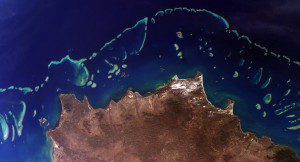
Australia's Great Barrier Reef is one of many reefs that CORAL will study beginning in 2016. (Credit: NASA)
A new three-year NASA field expedition will use advanced instruments on airplanes and in the water to survey more of the world's coral reefs in greater detail. The COral Reef Airborne Laboratory (CORAL) will measure the condition of these threatened ecosystems and create a unique database of uniform scale and quality.
Coral reefs are home to a quarter of all ocean fish species. They protect shorelines from storms and provide food for millions of people, yet little of the world's reef area has been studied scientifically.
Right now, the ˜state of the art' for collecting coral-reef data is scuba diving with a tape measure, said Eric Hochberg, CORAL principal investigator and scientist at the Bermuda Institute of Ocean Sciences, St. George's. It's analogous to looking at a few trees and then trying to say what the forest is doing.
CORAL will use an airborne Portable Remote Imaging Spectrometer (PRISM), developed and managed at NASA's Jet Propulsion Laboratory in Pasadena, Calif. Concurrent in-water measurements will validate the airborne measurements of reef condition.

